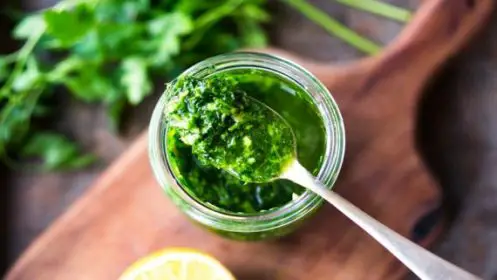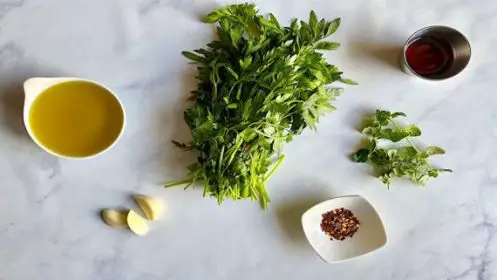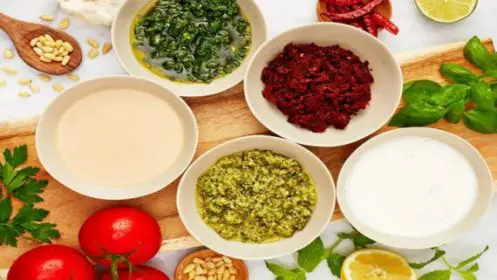Eating gremolata vs Chimichurri can be a difficult decision. Both are delicious, but gremolata is often made with parsley and olive oil, while Chimichurri is mainly made from garlic and parsley.
They also have different origins: gremolata comes from Italy, while Chimichurri originates in Argentina.
Chimichurri is more popular because it’s easier to make and has a slightly sweeter flavor than gremolata.
However, gremolata leaves the taste of fresh herbs on your tongue, which some people prefer over the intense flavors of garlic and parsley found in chimichurri sauce. It’s important to note that both sauces go.
What is gremolata?

Gremolata is a sauce or condiment usually served with Italian dishes such as ossobuco, veal scaloppine, and zabaglione. It’s typically made using fresh parsley, garlic cloves (or shallots), olive oil, and lemon juice.
What is Chimichurri?

Chimichurri is a type of sauce from Argentina, and the word means ‘herb-based in Spanish. It contains plenty of parsley, olive oil, garlic cloves, and salt. Parsley leaves are often crushed with a pestle or smashed through a garlic press to release the oils.
How to Prepare Gremolata?
Gremolata is usually prepared by cutting the parsley and garlic into thin slices, then chopping them finely. The zest of one lemon should be cut very thinly before adding it to the mix.
Ingredients:
- parsley
- garlic,
- finely chopped or minced
- lemon zest (thinly sliced)
Instructions:
Grate the lemon and garlic with a Microplate grater. Chop the parsley coarsely, then mix in a small bowl. Add salt to taste after cooking is complete.
How to Prepare Chimichurri?
Chimichurri is a type of herb-based sauce that originated in Argentina. To prepare Chimichurri, it’s best to start with a base of olive oil, garlic, and salt.
Then you can add parsley (you may want less than gremolata), cilantro (optional), or any other herbs you like, such as thyme or oregano. Add lemon or lime juice to brighten the flavor.
Ingredients:
- olive oil
- gremolata or chimichurri
- chopped parsley (optional)
- cilantro (optional)
Instructions:
In a bowl, combine gremolata or chimichurri ingredients with olive oil. Add the chopped parsley and cilantro if using lemon juice (or lime) to taste. Mix thoroughly before serving over steak, fish, chicken breast, or vegetables.”
Why are these two sauces popular
Gremolata and Chimichurri are popular because they’re versatile, easy to make, and can be used in many different dishes.
Both sauces aim for a fresh flavor that doesn’t overpower the food’s natural taste. Which one you prefer is up to personal preference!
Which sauce is better to use in what dish?
Gremolata is a good choice for dishes with more robust flavors, such as roasted vegetables or any word that contains cheese.

Chimichurri should be used in more subtle foods like grilled shrimp and fried eggplant chips. Which sauce you decide to use will depend on what food it’s being paired with.
Gremolata vs Chimichurri – who wins the battle of the sauces?
Both sauces are great, but they’re best used in different dishes. Which one you use depends on the flavors of your plate!
Shallot:
Gremolata and Chimichurri both call for shallots.
Olive oil:
Both sauces contain olive oil as their base ingredient.
Herbs:
Chimichurri calls for parsley, while gremolata uses chopped thyme and basil. Which is better depends on your preference!
Spices:
Gremolata’s prominent spice is grated lemon zest, while Chimichurri often contains paprika, garlic powder, and cayenne pepper.
Chimichurri can be heavy on spices, which means you have to like it for it to work well with your dish!
Gremolata:
Gremolata is a more versatile sauce because it’s light and refreshing. Which one you use depends on the flavor profile of your dish!
Chimichurri:
Chimichurri is heavier, so if you’re looking for something to give your dishes an extra punch, this might be the one for you.
Differences between the two sauces
Which is better: gremolata vs chimichurri. Gremolata has parsley and thyme, while Chimichurri uses basil and cilantro.

Chimichurri can be heavy on spices, which means you have to like it for it to work well with your dish!
Gremolata is a more versatile sauce because it’s light and refreshing.
Chimichurri has parsley, thyme, basil, and cilantro, while gremolata has just parsley and thyme.
Ultimately, both sauces are unique on their own. Which one you use depends on the flavor profile of your dish and your personal preference.
Which sauce should you choose for your dish?
Chimichurri is usually heavier in spices, so it’s best for dishes with a meat or tomato-based sauce.
Gremolata can be used on fish, chicken, and rice dishes because the lightness of this sauce compliments those flavors well.
You may like: Best Chinese Food In Connecticut
Tips on how to use each of them in different dishes

Chimichurri:
Use as a marinade for meats, including beef and chicken.
Add to tomato or meat-based sauces like BBQ sauce or pizza sauce.
Gremolata:
Sprinkled on fish, chicken, or pork
Add to rice dishes like pilafs and risottos. This sauce goes well with various flavors, so it’s great for adding lots of flavors without overpowering the dish.
Gremolata is usually lighter in spices, so it’s best for dishes with a meat or tomato-based sauce.
Tips on how to use each of them in different dishes

Chimichurri is excellent as a marinade for meats, including beef and chicken. Add to tomato or meat-based sauces like BBQ sauce or pizza sauce. Gremolata is usually lighter in spices, so it’s best for dishes with a meat or tomato-based sauce.
Conclusion
Gremolata comes from the Italian word ” Gremolata,” which means parsley. Chimichurri is a sauce that originated in Argentina, and it combines garlic, vinegar, oregano, salt, and pepper with olive oil to make an herb-based condiment for grilled meats.
If you have any other questions about either dish or how they’re used in recipes, let us know! We’ll be happy to help out as much as we can!

2 thoughts on “Which is better: gremolata vs Chimichurri 9 Facts”